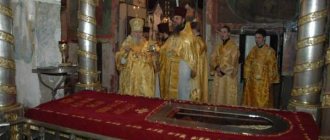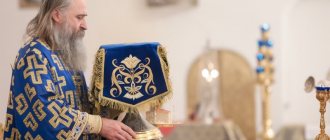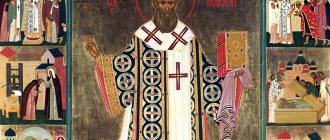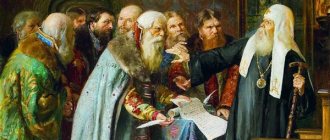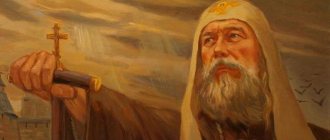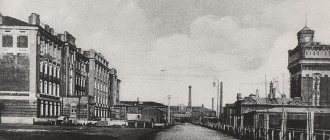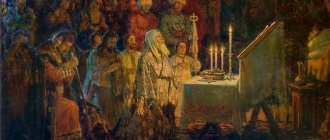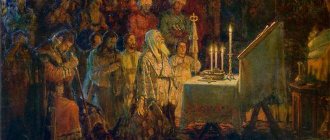| St. Cyprian. Icon (XVII century) from the Assumption Cathedral of the Moscow Kremlin |
Cyprian (Tsamblak)
(c. 1330 - 1406), Metropolitan of Kiev and All Russia, Saint Memory May 27 - discovery and transfer of relics in 1472, September 16 - repose, in the Cathedral of Moscow Saints, in the Councils of Bulgarian, Volyn, Galician, Kiev and Moscow saints; Saints of Athos and Hilendar, as well as Russian Saints of Svyatogorsk
Born around 1330 in the city of Tarnov, which at that time was the capital of the Bulgarian kingdom. It is not known for certain what his nationality was; according to some sources - a Bulgarian, according to others - a Serb from Tarnovo [1]. After completing his school education in his hometown, Cyprian, feeling an attraction to monastic life, on the advice of his spiritual mentor and relative Blessed Euthymius, asceticised on Athos.
On Mount Athos and Constantinople
Saint Cyprian himself speaks about his life on the Holy Mountain in his letter to Abbot Athanasius. It is not known exactly which of the Svyatogorsk monasteries the monk Cyprian labored in. Most likely, in one of the Slavic monasteries (possibly in Stary Rusik, inhabited at that time by his fellow countrymen from Serbia and Bulgaria) and in the Lavra of St. Athanasius. Although, judging by the nature of the message of the Bulgarian Patriarch Euthymius to Saint Cyprian, we can assume that he labored for some time outside the monastery, in the desert.
Asceticizing on Holy Mount Athos, the future saint was closely connected with the Serbian Hilandar monastery, Stary Rusik, the monastery of St. Paul and the Great Lavra of St. Athanasius, where the future Hesychast Patriarch Philotheus (Kokkin) was a resident. Acquaintance with the latter played an important role in the fate of the saint [2].
After leaving the patriarchal throne for the first time in 1354, Patriarch Philotheus remained on Mount Athos until 1364. The learned monk Cyprian, who was engaged in translations from Greek, became known to the disgraced patriarch. From here comes their spiritual connection, which turns into filial love and devotion on the part of the former and paternal affection and patronage on the part of the latter. Thus, during the second accession of Saint Philotheus (Kokkin) to the patriarchal throne in 1364, Cyprian was already under the patriarch as “his neighbor monk”
, that is, an assistant. The desire to have an assistant in reconciliation with neighboring Slavic Churches and strengthening influence on the Russian metropolis fully explains the reason why the patriarch brought closer to himself the learned monk, whom he had recognized and appreciated back on Mount Athos.
The choice was a complete success. During his second patriarchate (1364-1376), the patriarch reconciled with the Serbian and Bulgarian Churches and strengthened his influence on the Russian Church, and achieved all this with the assistance of the monk Cyprian. Reconciliation with the Bulgarian Church, whose primate until the fall of Tarnov in 1389 was the blessed Patriarch Euthymius, teacher and mentor of St. Cyprian, could not present any particular difficulties. It was more difficult to achieve reconciliation with the Serbian Church, with which all communication was interrupted. But here, too, things were settled at the beginning of 1375 through the efforts of the same monk Cyprian and the venerable Athonite monk Isaiah.
Activities in Lithuania and Russia
Around 1373, Cyprian, by the will of Patriarch Philotheus, was sent to Lithuania and Russia to reconcile the Lithuanian, Smolensk and Tver princes with Metropolitan Alexy of All Russia: “the patriarch sent, to speak to the council, Cyprian, his own monk, a peace-loving and God-fearing man who knows how to prudently take advantage of circumstances and manage affairs, sent him to reconcile the princes with each other and with the metropolitan"
. During a trip through the Russian-Lithuanian lands, Cyprian met with the princes of Lithuanian Rus and found support from them.
As a result of the efforts of the patriarchal ambassador in the winter of 1373/1374, Prince Mikhail of Tver renounced his claims to the Great Reign of Vladimir, and Metropolitan Alexy lifted the previously imposed excommunication from him. In Tver, a new Bishop Euthymius (Wislen) was installed at the dowager see. Cyprian participated in this production.
At the end of winter, Alexy installed Pechersk archimandrite and friend Cyprian Dionysius as Bishop of Suzdal and Nizhny Novgorod. Lithuania takes an active part in the anti-Tatar movement: “Lithuania went to Tatariv, to Temrya, and there was a battle between them”
. A powerful all-Russian coalition is taking shape. The basis of this coalition was the Grand Duchy of Lithuania and the great principalities of Moscow, Tver and Nizhny Novgorod. However, due to the intrigues of the Horde, the coalition did not last long. The confrontation over the grand ducal primacy between Tver and Moscow intensified. Prince Mikhail again claimed his rights to Vladimir, and a military confrontation began between Moscow and Tver. Together with Tver, Lithuania also left the coalition. The matter ended with the campaign of Dmitry of Moscow in 1375 against Tver.
Since in the confrontation that broke out, Metropolitan Alexy of Kiev, who lived in Moscow, took the side of the Moscow prince, Lithuanian Russia refused to obey his orders and the dissatisfied princes sent a large embassy with a letter to the patriarch, begging him to give them a special metropolitan for southwestern Russia, saying that otherwise they “will be ready to start another church”
.
After a conciliar discussion about this, Patriarch Philotheus, guided by the desire to preserve peace, decided to make a concession to their request, and in December 1375 he ordained Cyprian to the rank of Metropolitan of Kyiv for Lithuania. At the same time, at the Council of Constantinople, it was decided, in order to avoid the division of the Russian metropolis, “ after the death of St. Alexei, he should be the Metropolitan of All Russia
.”
Metropolitan of Kyiv
On June 9, 1376, Cyprian arrived in Kyiv, which was under the rule of the Lithuanian prince Vladimir Olgerdovich, and began to organize the life of the dioceses of the Kyiv Metropolis subordinate to him within the Grand Duchy of Lithuania. In Moscow they refused to recognize such an appointment and continued to consider Kyiv and other southwestern Russian dioceses under the authority of Metropolitan Alexy, who lived in Moscow.
On February 12, 1378, Metropolitan Alexy died. According to the cathedral resolution, Cyprian had to extend his powers to the entire Kyiv Metropolis. On June 3 from Lyubutsk, he writes to abbots Sergius of Radonezh and Theodore Simonovsky about his intention to arrive in Moscow. However, on the instructions of Prince Dmitry Ivanovich, on the way to Moscow, Saint Cyprian was arrested, robbed and imprisoned, and later expelled in disgrace outside the Moscow principality. After this, Saint Cyprian hastened to the protection of princes Dmitry and Vladimir Olgerdovich and on June 23 wrote a second letter to abbots Sergius and Theodore, in which he argued that it was inadmissible to appoint the white priest Mityai as metropolitan “by will.”
and anathematized Prince Dmitry Ivanovich.
In 1380, after the death of the candidate Mityai, chosen by the Grand Duke of Moscow Dmitry Ivanovich, Cyprian was recognized as metropolitan in the Moscow state, but not for long.
But, in 1382, after the devastation of Moscow by Tokhtamysh, circumstances changed again. When Tokhtamysh approached Moscow in August 1382, Cyprian stayed in the capital somewhat longer than the Grand Duke, but in the end he also left the city and moved to Tver. In the fall of 1382, he returned to Moscow for a short time and witnessed the arrival of the Khan’s ambassador, Karach, who brought Dmitry the Khan’s “mercy”, and in fact accepted the prince’s surrender [3]. The Metropolitan became displeasing to the prince, including as a likely ally of Jagiello, and Dimitri Donskoy returned him back to Kyiv, and called Pimen in his place. Together with Cyprian, hegumen of the Serpukhov Vysotsky Monastery Afanasy went to Lithuania.
In 1385, Metropolitan Cyprian was summoned by Patriarch Nilos to Constantinople for a canonical investigation of the situation in the Russian Metropolis. He arrived in the capital together with the patriarchal ambassadors, who completed the investigation into the Pimen case in Moscow. And on this trip he was accompanied by Abbot Afanasy. In Constantinople, the Metropolitan settled in the Studite monastery, famous for its library, and was engaged in translating texts from Greek into Slavic. Among other things, he translated the works of Dionysius the Areopagite. Cyprian compiled the Euchologium, which later served as a basis for reform in the liturgical practice of the Russian Church, and on April 27 he finished rewriting the Ladder of John of Sinai. During this time, Cyprian, as Metropolitan of Kiev, repeatedly participated in meetings of the Synod of the Church of Constantinople.
On May 29, 1387, Saint Cyprian again departed for Rus'. After this we see Met. Cyprian in Kyiv and Lithuania, where he managed to convince the Lithuanian prince Vytautas to lead the anti-Polish coalition and reconcile with the Moscow princes.
In February 1389, at the Council in Constantinople, Saint Cyprian was finally confirmed in the status of the single Metropolitan of Kyiv and All Rus', and the Moscow Metropolitan Pimen was deposed. Soon, on May 19, Grand Duke Dmitry Donskoy died and there were no more obstacles to the return of Saint Cyprian to Moscow.
From Kyiv, Saint Cyprian arrived in Moscow on March 6, 1390. While ruling the Church in two different powers, he knew how to maintain the unity of the churches and strictly persecuted the untruths of the bishops. He visited Kiev twice, and traveled to other southern dioceses to “confirm the Orthodox in piety.”
. Participated in the council that condemned Patriarch Macarius; converted three khan's nobles to Orthodoxy.
In the spring of 1399, Metropolitan Cyprian came to Tver, where he blessed the political union between Moscow and Tver, directed against Lithuania.
During his next trip to the Western Russian dioceses in the spring and summer of 1399, Metropolitan Cyprian, it seems, managed to achieve the transfer of the Galician Metropolis under his omophorion, and without the approval of Constantinople (officially, the Patriarchate of Constantinople announced the reunification of Galicia with the Metropolis of Kyiv and All Rus' only under Cyprian’s successor, Photius ). The charter of the Polish king Vladislav II Jagiello to the Przemysl episcopal see, issued at the request of Metropolitan Cyprian, has been preserved. In this document, Cyprian is called “Metropolitan of Kyiv, Galicia and All Rus'” [4]. From this title it is clear that the right to the Galician metropolis was recognized by the king as Cyprian.
At the beginning of 1401, the Polish king Vladislav Jagiello and the Grand Duke of Lithuania Vytautas concluded a new state union between Poland and Lithuania, which was named Vilna-Radom after the place of conclusion. According to this document, Poland and Lithuania were declared union states. The alliance with Poland contributed to the strengthening of Vytautas, who on June 26, 1404, after a long siege, captured Smolensk for the second time. Perhaps the trip of Metropolitan Cyprian to the Grand Duchy of Lithuania in July 1405 - January 1406 could have been connected with the recapture of Smolensk by the Lithuanians. Another important goal of his visit was to eliminate the abuses committed by representatives of the metropolitan governorship in the Kiev land, which resulted in radical personnel changes in Kiev: “the archimandrite Timothy, his deputy, and his servants there were sent to Moscow.”
.
“Theodosius, Archimandrite of Spassky”
as his new governor in Kiev
chose “his servants”
to help him , commanding them
to “be in Kiev with his archimandrite viceroy
.
January 1, 1406, while in the Grand Duchy of Lithuania, “one summer and 5 months”
, Metropolitan Cyprian returned to Moscow, where he performed numerous episcopal consecrations.
In the autumn of 1406, Cyprian became seriously ill, died on September 15 in the village of Golenishchevo near Moscow and was buried in the Assumption Cathedral of the Moscow Kremlin on September 16.
His relics were discovered on May 27, 1472 during the construction of the new stone Assumption Cathedral in the Kremlin and were placed in the Moscow Assumption Cathedral under cover.
In the history of the Russian Church, Metropolitan Cyprian occupies an important place as a figure in the field of correcting church liturgical books and church rituals. In the Russian Church, the Studite Rule was initially adopted, revised by St. Theodore the Studite and dominated in Byzantium until the end of the century, when a different type of church charter, the Jerusalem one, began to come into use there in the 14th century. finally strengthened throughout the East and among the southern Slavs. The Russian Church then began to receive liturgical books from the East, compiled in relation to the new order; Clergymen also came from the East in large numbers, accustomed to the Jerusalem Rule and applying it in Russia. Hence a number of perplexities, which sometimes became acute, and the need to review the entire range of liturgical books compiled according to the principles of the Studite Rule, in order to correct them in accordance with the principles of the Jerusalem Rule. Metropolitan Cyprian contributed greatly to the resolution of this problem; but it was beyond the power of one person to completely correct the liturgical books. In the liturgical books that we consider to have belonged to Cyprian or copied from books that belonged to him - the service book and missal - only some individual parts were translated by Cyprian and partly adapted to the needs of Russian practice. There is no doubt that St. Cyprian Psalter (manuscript of the Moscow Theological Academy).
In general, the activities of St. Cypriana was aimed more at setting the task than at implementing it in detail. Some minor articles of liturgical content are also attributed to St. Cyprian, some translated, some independent; but only a few of them can be considered the works of St. Cyprian. The last category of literary works of Metropolitan Cyprian is formed by his letter to Abbot Athanasius, a teaching to the Novgorod clergy on church services and a letter to the Pskov clergy with instructions on various subjects of ministerial practice. Studying these works of St. Cyprian is important for clarifying the disagreements that arose when Patriarch Nikon corrected the books; they shed light on the liturgical orders of the 14th centuries. and on their attitude to the orders introduced under Nikon.
St. Cyprian, during his tenure at the metropolitan see, unwittingly contributed to strengthening the positions of Moscow and the Grand Dukes of Moscow. In the 1390s, he achieved the abolition of the Galician metropolitanate, replaced almost all the bishops and set a course for strengthening the independent position of the church and its ties with Constantinople, but never supported the Moscow grand-ducal power in the conflict with Lithuania.
Prayers
Troparion, tone 4
Who is from God above perfected by Divine grace/ and adorned with good morals,/ enlightened by the Holy Spirit,/ having accomplished holiness in the passion of God,/ made worthy of the swift grace of the Divine Spirit,/ passing The Church of God of the Russian Metropolis, / having overcome everything by fasting, endured unrest, overcome persecution, / always calling on St. Peter the Metropolitan for help, / and having this helper, / and following in his footsteps. / An acceptable servant, / keeping the commandments of God, we instruct with the Spirit of God, / enlightening “I am a faithful people with the teaching of your words, / adorn your life with mercy, / We will take the yoke of the Lord from childhood, / and love Christ above all. / For this sake, I am honored by the bishop’s seat, / and, like the shining sun, I came from the Serbian land, / and to all ends Ru The Russian lands shone with virtue,/ the luminary appeared to the world,/ and passed away to the Lord from sowing life to eternal rest, / the great bishop of God, Metropolitan Cyprian, / teacher and mentor of the Russian land, / always standing before the throne of the Most Holy Trinity, / pray to the Lord It is important / about the bishops and about all Christians, / / may he save you for the sake of your soul our.
Troparion, tone 4
Orthodoxy to the teacher,/ enlightenment to the zealot,/ the beauty of the Bulgarian country/ and Russia’s glorious lamp,/ our holy father Cyprian,/ pray to Christ God// to preserve our faith until the end of the world ka.
Kontakion, tone 2
The unconquerable pillar of Orthodoxy, the affirmation of the faith of Christ, the beautifier of the churches, the wise teacher, Serbian education, Russian prosperity, we are inflamed by the love of the Lord, Holy Spirit I have appeared to my house/ and brought my soul, like a blameless sacrifice, to the Lord,/ most wonderful and honorable Cyprian, Saint of Christ, / For this reason, dwell in the vastness of paradise, / stand before Christ in the face of the saints, / Pray to Him and save the city and people from the filthy presence, / for let us call you // ra Pout, Father Cyprian, to the wise teacher.
Kontakion, tone 6
To the Saint of Christ,/ good shepherd,/ teacher of heavenly wisdom,/ lamp of spiritual light,/ most wonderful Cyprian,/ do not cease to pray for your flock,/ for those who love and honor you,// strong intercessor of our city.
Veneration in Orthodoxy
The day of veneration of Metropolitan Cyprian in the Orthodox Church is September 29. In addition, the saint is remembered on such days:
- Cathedral of Moscow Saints - September 5;
- Cathedral of Moscow Saints - October 18;
- Cathedral of Volyn Saints - October 23;
- The discovery and transfer of the relics of Saints Cyprian, Photius and Jonah - June 9.
Used materials
- Encyclopedic Dictionary of Brockhaus and Efron.
- Pravoslavie.ru
portal calendar page : - “Saint Cyprian, Metropolitan of Kiev and All Rus'” // Official website of the Russian Orthodox Church:
- Menea. September, ed. Moscow Patriarchate, p. 461-462 (prayers):
- Saint Cyprian of Kiev: Athonite ascetic-hesychast and Metropolitan of All Russia // Orthodox information and educational portal Russian Athos
: - Maleto E.I. Medieval Rus' and Constantinople. Diplomatic relations at the end of the XIV - mid-XV centuries. / E. I. Maleto - “Connections of Rus' with Athos under St. Cyprian (Tsamblak) of Kiev and their influence on the peculiarities of the veneration of the Holy Trinity” // Orthodox information and educational portal Russian Athos
,[3] Meyendorff I., prot. Byzantium and Muscovite Rus': Essay on the history of church and cultural relations in the 14th century. Chapter X. Lithuania turns to the West, Paris: YMCA-PRESS, 1990,
[4] History of the Russian Orthodox Church: In 2 volumes / Rep. ed. R.I. Avdeev; scientific ed. T.Yu. Timofeeva. T. 1. History of the Russian Church from the beginning of the spread of Christianity in Rus' to the establishment of the Patriarchate in Moscow (1589). M., RossPEN, 2015. P. 245.
Saint Cyprian, Metropolitan of Moscow, Kiev and All Rus'
Cathedral of Moscow Saints (fragment). Icon. Moscow. XIX century. The eastern edge of the southeastern pillar of the Assumption Cathedral. Trinity-Sergius Lavra.
Metropolitan Cyprian (c. 1330 - September 16 (29), 1406) - Metropolitan of Kiev, Russia and Lithuania (1375-1380), Metropolitan of Little Russia and Lithuania (1380-1389), Metropolitan of Kiev and All Russia (1389-1406), Christian politician, translator and book writer. In 1472 he was canonized. The role of this man in Russian history is great. The goals for which Cyprian worked, his policies and activities are so significant that they deserve closer attention and serious study.
In Rus' at that time there was a stubborn struggle for primacy between two forces: Moscow, on the one hand, and the Grand Duchy of Lithuania in alliance with Tver, on the other. Despite the Tatar-Mongol invasion and the seizure of virtually all of Eastern Europe by the Horde, Constantinople retained its church administration in this territory. Moreover, the Horde accepted this factor as absolutely legitimate and took it into account when organizing its administrative system, even after Islam was adopted in the Horde at the beginning of the 14th century. That is why the Russian Church, unlike the Russian principalities, was exempt from tribute to the Horde. The recognized head of the Russian Church was Constantinople.
In the struggle for the primacy of the principalities in Eastern Europe, Constantinople clearly supported Moscow. Even Saint Peter, having been installed in Rus' in 1309 as Metropolitan of Kiev and All Rus', settled not in Kyiv, but, ultimately, in Moscow and began to pursue an openly pro-Moscow policy. The Lithuanian prince, naturally, was dissatisfied with this, since the Metropolitan of All Rus' ruled the Orthodox churches in Lithuania.
M. Gorelik. White and black clergy of the 15th - mid-17th centuries.
The prince complained to Constantinople and demanded that his metropolitan be installed in Lithuania. The next metropolitan, Theognostus, was Greek, but he immediately came to live in Moscow, also pursued a pro-Moscow policy and also displeased Lithuania. Alexy, the next Metropolitan of Kiev and All Rus', who, due to the minority of Prince Dmitry Ivanovich, was the de facto ruler of Moscow, was Russian and sometimes took very bold political steps in the interests of Moscow. And again Lithuania was dissatisfied, and again the Lithuanian prince wrote complaints to Constantinople and demanded that they be given their own metropolitan. Constantinople behaved cautiously, but at the same time, as they say, it stood to death and only sent letters to the complainants, in which it persuaded them not to quarrel with the Metropolitan of All Rus', and sometimes even advised them to ask for his forgiveness.
Saint Cyprian was born around 1330 in the city of Tarnovo, the capital of Tarnovo Bulgaria. It is believed to belong to the Bulgarian Tsamblakov family. Apparently, Cyprian left Bulgaria quite early and went first to Constantinople, and then to Athos, where he labored in one of the Athos monasteries. In Byzantium, Cyprian became close to a prominent representative of hesychasm, Philotheus Kokkin, later the Patriarch of Constantinople. Emperor John Cantacuzene and Patriarch Philotheus directed all their efforts towards the unification of the Orthodox world, including the unification of Rus' and, in particular, the establishment of the authority of Moscow; the future Russian Metropolitan Cyprian came out of these political circles.
Saints Photius, Theognostus and Cyprian
It is known that on this first trip to Rus', Cyprian successfully contributed to the reconciliation of Moscow with Tver and Lithuania. He traveled to Lithuania and visited Russian cities with Metropolitan Alexy. In 1375, the Lithuanian princes asked Patriarch Philotheus to appoint Cyprian as Metropolitan of Lithuania. On December 2, 1375, Patriarch Philotheus ordained Cyprian as Metropolitan of Kyiv, Russia and Lithuania so that after the death of Metropolitan Alexy he would become the Metropolitan of Kyiv and All Rus'. But this formulation was not accepted by the Moscow prince, and therefore, when Metropolitan Cyprian arrived in Kyiv on June 6, 1376, his attempts through ambassadors to achieve recognition of his rights from Moscow, Novgorod and Pskov remained in vain.
On February 12, 1378, Metropolitan Alexy died at the age of 80. Metropolitan Cyprian went to Moscow with the intention of taking over the rights of inheritance against the will of the prince. Previously, he sent messengers with letters to abbots Sergius of Radonezh and Theodore Simonovsky with a request to support him in Moscow. But at the entrance to Moscow he was captured, robbed, spent the night in captivity, and then was rudely, with mockery, expelled from Moscow.
There is every reason to believe that just in these years, that is, at the end of the 70s of the 14th century, the boyar party strengthened in Moscow, which saw the political path of Moscow in subordination to the Horde and in collaboration with the Genoese merchants - Catholic opponents of Constantinople, as the path more reliable and calm. The Horde's policy was closely connected with Genoese trade in Crimea and Sarai. The Genoese followed the relations between Rus' and the Horde very closely and were extremely uninterested in the rise of Moscow, as well as in its alliance with Lithuania.
Genoese and Venetian merchants seized all trade in the Black and Mediterranean Seas, also had economic and political ties with the Horde and kept the economy of Constantinople in bondage. At the same time, Genoa and Venice waged a fierce struggle among themselves for supremacy in the world market and actively took advantage of political unrest both in Constantinople and in Rus'. Cyprian, a protege and like-minded person of Patriarch Philotheus, an enemy of the Catholic Genoese, was clearly undesirable to these political circles.
Apollinary VASNETSOV. Monastery in Moscow Rus'
Mityai was nominated as a candidate for the metropolitan throne, who for this purpose was tonsured a monk with the name Mikhail and made archimandrite of the Moscow Spassky Monastery. The Grand Duke wanted to see his protege, Archimandrite Mikhail, at the Moscow see. He even thought about establishing Mikhail-Mityai, bypassing the Patriarchate of Constantinople, right in Moscow, and with the rank of Metropolitan no longer of Kyiv, but of Great Rus'. But this could not be accomplished canonically, and Mityai went to Constantinople to be ordained, where by this time Patriarch Philotheus was no longer there. Cyprian also went there, but on a different route. On the way, Cyprian wrote and sent several letters to abbots Sergius of Radonezh and Theodore Simonovsky. In these messages, he reproached the Muscovites for failing to support their legitimate metropolitan in the conflict with the prince and, describing his misadventures, expressed indignation at the prince’s behavior, but at the same time wrote that he revered him as the Grand Duke of All Rus' and prayed for him and his family .
“Bogolyubskaya” with selected saints (Left fold: Moscow saints Alexy, Cyprian, Philip and Stephen of Perm). Istoma Savin. Icon (three-leaf folding). Moscow. End of the 16th - beginning of the 17th century.
And then events happen that are truly worthy of an adventure novel. The contenders for the throne of Metropolitan of All Rus' resolutely headed to Constantinople. When the protege of Grand Duke Dimitri, Mikhail-Mityai, crossed the Black Sea and was already approaching Constantinople, visible in the distance, he fell ill right on the ship and suddenly died. The retinue accompanying him, with a sizeable metropolitan treasury, was in complete confusion. However, after consulting, they decided not to return to Moscow without the metropolitan, but to quickly elect another candidate from among the clergy who accompanied Mityai. After heated debates, Pereyaslav Archimandrite Pimen was elected.
The Moscow delegation decided to present the matter in such a way that Pimen was the envoy of the Grand Duke. Stormy intrigues and bribery began. Huge sums of money were borrowed from the Turks and Genoese against princely bills. The Patriarch announced that he would ordain Pimen as Metropolitan of Kyiv and Great Rus', and Cyprian as Metropolitan of Lithuania and Little Russia. Saint Cyprian did not wait for the act of ordaining Pimen and left for Lithuania. This was in the summer of 1380.
On September 8, 1380, the Battle of Kulikovo took place. In 1381, Grand Duke Dimitri sent Simon's abbot Theodore to Kyiv "according to Cyprian" with an invitation to Moscow. (Pimen was still in Constantinople at that time.) On the Feast of the Ascension of the Lord in 1381, Cyprian was solemnly greeted in Moscow and recognized as Metropolitan of Kyiv and All Russia. In the autumn of the same year, 1381, Pimen returned to Moscow from Constantinople. True, he, just like Cyprian in his time, was not allowed to reach Moscow. In Kolomna he was captured and thrown into prison. Some of his retinue were even executed for arbitrariness.
Grand Duke Dmitry Ioannovich and Prince Vladimir Andreevich Serpukhovskoy notify St. Cyprian about the upcoming campaign of Mamai and ask for advice. Miniature from “The Tale of the Massacre of Mamayev”
Metropolitan Cyprian, recognized by Moscow, immediately got down to business. He established in Moscow the veneration of Grand Duke Alexander Nevsky, who, on the one hand, was the direct ancestor of Dmitry Donskoy, and on the other, the winner of the crusaders. At the moment, Lithuania was in a state of fierce struggle with this knightly order.
At the same time, Cyprian wrote the life of Metropolitan Peter. In this life, he raised many issues of the relationship between the church and princely authorities, which were also relevant for himself. He also compiled a service for this Moscow saint, a commendation and a prayer canon.
However, the situation soon changed dramatically again. In August 1382, the Tatars, led by Khan Tokhtamysh, approached Moscow, took it and left it to devastating destruction. Dmitry was forced to flee and again recognize the power of the Golden Horde over himself. Cyprian was the first Russian metropolitan who never traveled to the Horde and never had any relations with the Tatars. He left Moscow and went to Kyiv. Dimitri made peace with Pimen and gave him the metropolitan see in Moscow, although not all the Moscow clergy agreed with this.
The period from the autumn of 1382 to the spring of 1390 is called in the history of Rus' the period of church unrest. Trips to Constantinople began for Cyprian, Pimen and other contenders for the metropolitan throne. The situation was finally resolved only with the death of its main participants. Grand Duke Dimitri Donskoy died on May 19, 1389 in Moscow. His body found peace in the Archangel Cathedral of the Moscow Kremlin.
Metropolitan Pimen, before reaching Constantinople, died on September 11, 1389. He was buried in the same Genoese Galata where Mitya was.
On August 15, 1389, on the day of the Dormition of the Mother of God, Vasily Dmitrievich was elevated to the Grand-Ducal throne of Moscow in Vladimir.
But back in February 1389, that is, during the lifetime of Grand Duke Demetrius and Metropolitan Pimen, the new Patriarch of Constantinople Anthony deposed Pimen and confirmed Cyprian’s rights to the see of Metropolitan of Kyiv and All Rus'. On October 1, 1389, on the Intercession of the Mother of God, Cyprian left Constantinople. On March 6, 1390, during the Cross Worship Week of Lent, he arrived in Moscow, accompanied by Greek and Russian clergy. Here he was lovingly met by the new Moscow prince Vasily Dmitrievich with his mother, Princess Evdokia Dmitrievna, and with all the boyars. Moscow finally unanimously recognized and accepted the already 60-year-old Cyprian. This was followed by the 17-year reign of Cyprian, Metropolitan of Kyiv and All Rus', before God at the head of the Russian Orthodox Church.
The Savior on the throne with the falling St. Cyprian. Zinoviev G.T. Icon. Moscow. 1700 According to legend, written under St. Cyprians. In 1518, under Metropolitan Varlaam, it was moved from Vladimir to Moscow, where it was renewed and decorated with a frame.
Once at the metropolitan see in Moscow, Cyprian remained faithful to his main strategic idea and the tradition of Patriarch Philotheus - the strengthening of Ecumenical Orthodoxy and the struggle for the unity of the Orthodox community. Being an outstanding expert on Orthodox worship in Constantinople, Athos, and Bulgaria, the saint began active work to correct and bring to unity liturgical practice in the Russian Church. Metropolitan Cyprian himself copied such liturgical and doctrinal books as the Psalter, the Service Book, the Breviary, the Ladder of John of Sinai, the works of Dionysius the Areopagite, and translated some prayers and canons of Patriarch Philotheus from Greek into Slavic. It was Metropolitan Cyprian who brought to Rus' and disseminated for reading the interpretation of the Gospel of St. Theophylact of Bulgaria.
The latest research tends to believe that not without the literary influence of Cyprian, the famous works of the Kulikovo cycle arose: “Zadonshchina”, a lengthy edition of the chronicle “The Tale of the Battle of Kulikovo”, “The Tale of the Invasion of Tokhtamysh”, “The Tale of the Life and Death of Grand Duke Dmitry Ivanovich” , Russian Tsar" and the original work "List of Russian cities, distant and close." It is also expected that Metropolitan Cyprian will participate in the creation and editing of the Moscow chronicle of 1408, known as the “Trinity Chronicle”.
In modern philological science, the era of Cyprian in Rus' is usually called the time of the “second South Slavic influence.” It was precisely in those years that the Balkan countries plunged into the darkness of Turkish rule for many centuries. On July 19, 1389, a tragic battle took place on Kosovo Field. In 1393, the capital of Bulgaria, Tarnovo, fell to the Turks. As a result, the emigration of cultural forces from the Balkans to Rus' began. The second “golden age” of Bulgarian literature extended its existence in Rus'. Of course, the presence of the Bulgarian Cyprian at the primatial see contributed to this cultural phenomenon.
The emergence of a new direction was observed at this time in Rus' not only in the field of literature, but also in the fine arts. Personalities such as Theophanes the Greek, Daniil Cherny, and Reverend Andrei Rublev appear. They differ sharply from the masters of the previous era, so to speak, in their professionalism, both purely artistic and philosophical and theological. It was in 1390 that Theophanes the Greek came to Moscow from Novgorod. And it is clear that by order of Metropolitan Cyprian, together with his associates Daniil Cherny, Andrei Rublev and Prokhor from Gorodets, he painted the Kremlin cathedrals.
St. Cyprian. Icon. Moscow. XVII century Assumption Cathedral of the Moscow Kremlin.
These universal masters apparently also took part in decorating manuscripts. Thus, in the first years of the 15th century they made miniatures for the famous manuscript of the Khitrovo Gospel.
Contemporaries assessed Cyprian’s influence on the life of Rus' as follows: “With his blessing, the Russian land deeply accepts peace,” and “with his book correction and teaching it brightens more than the dawns of the sun and is watered as if from an ever-flowing source.”
But in addition to purely spiritual activities, the first hierarch of the Russian Church had to deal with the affairs of church administrative management. Cyprian actively visited the most important spiritual centers and cities of his diocese, installed bishops, monitored the observance of church canons, and was involved in legal proceedings. The main concern of Saint Cyprian was the reconciliation and unification of all the principalities located on the territory of his diocese. With his blessing, on January 9, 1391, the marriage of Grand Duke Vasily Dmitrievich with the Lithuanian princess Sofia Vitovtovna took place.
In the summer of 1395, alarming news came to Moscow: the hordes of Tamerlane (Timur), an invincible conqueror, were moving towards the city from the south. Tamerlane conquered Persia, Iraq, Armenia, Azerbaijan, Mesopotamia, Georgia, India and Syria. Tamerlane reached the Ryazan borders, ravaged the city of Yelets and approached the upper reaches of the Don. Grand Duke Vasily Dmitrievich went with the Moscow army to Kolomna. Metropolitan Cyprian, blessing Prince Vasily on his campaign, called on Muscovites to repentance, fervent prayer and nationwide fasting. Then he sent an embassy to Vladimir, consisting of clergy and boyars, for the Vladimir Icon of the Mother of God. They carried the icon to the capital in a religious procession for ten days. Moscow, led by the Metropolitan, the family of the Grand Duke, the clergy and boyars, met with tears the icon of the Most Holy Theotokos on Kuchkovo Field.
Presentation of the Vladimir Icon of the Mother of God. Icon. Moscow. XVII century
Today, the street along which the procession from Vladimir then took place is called Sretenka (from the Slavic word “sretenka” - “meeting”), and the gates that later appeared on the site of Kuchkov Field during the construction of the White City began to be called Sretensky. All of Rus' prayed in those days before the icon of the Mother of God. Tamerlane did not turn to Moscow and turned south. At the meeting place of the Vladimir Icon, Metropolitan Cyprian founded the Sretensky Monastery, and the day of August 26 (September 8 according to the new style) has been celebrated since then as the day of the salvation of Moscow and Russia from the hordes of Tamerlane. Turning south from Moscow, Tamerlane began the grandiose defeat of the Golden Horde. All the steppe cities, then hostile to Rus', were plundered and destroyed within one year. Khan Tokhtamysh, who burned Moscow in 1382 in revenge for the defeat on the Kulikovo Field, fled to Lithuania. After this total defeat, the Golden Horde virtually ceased to exist as a steppe civilization, as a single state.
The last work of Metropolitan Cyprian was his visit to the western regions of the metropolis in 1404–1405. It is known that Vytautas met him in Vilna with great honors and that Saint Cyprian was present at the special meeting of Jogaila and Vytautas in Milolub.
On January 1, 1406, Saint Cyprian returned to Moscow and on September 16, 1406, he died at his country residence. Before his death, he wrote the famous prayer of permission, which was read over his coffin.
Metropolitan Cyprian was buried in the southwestern corner of the Assumption Cathedral of the Moscow Kremlin, according to his own will.
On May 29, 1472, during the construction of the new and dismantling of the old Assumption Cathedral in the Kremlin, the relics of St. Cyprian were found and transferred to the new cathedral. This year is considered the year of his glorification.
Facial calendar of Russian saints. September (sheet 1). Nun Juliania (Sokolova). Drawing. Sergiev Posad. 1959-1962 Fulfilled at the request of St. Athanasius of Kovrovsky /Sakharov/ (Letter dated September 30, 1959). Private collection.
Cathedral of the Holy High Priests of All Rus' (fragment). Nun Juliania (Sokolova). Icon. Sergiev Posad. Late 1950-80. "Metropolitan Chambers". Trinity-Sergius Lavra.
Lit.: Andreev V.F. From the history of the Russian Church of the XIV-XV centuries. Metropolitan St. Cyprian. Veliky Novgorod, 2008 Ch. Cyprian (saint, metropolitan of all Russia) // Russian biographical dictionary: in 25 volumes. - SPb.-M., 1896-1918. Glubokovsky N. N. St. Cyprian. Metropolitan of All Rus' (1374-1406), as a writer // Readings in the society of lovers of spiritual enlightenment. 1892—February. pp. 358—424. Archm. Leonid "Cyprian before his accession to the Moscow Metropolis." CHDOIR 1867 book. 2. p. 11-32. Dmitriev L.A. The role and significance of Metropolitan Cyprian in the history of ancient Russian literature: On the history of Russian-Bulgarian literary relations of the XIV-XV centuries.//TODRL. 1963. T 19. P. 215-254. Prokhorov G.M. The oldest manuscript with the works of Metropolitan Cyprian // Cultural Monuments. New discoveries. Yearbook for 1978—L., 1979. P. 17–30. Prokhorov G. M., Droblenkova N. F. Cyprian // Dictionary of scribes and bookishness of Ancient Rus'. Vol. 2. Part 1. M., 1988. pp. 464-473. G. M. Prokhorov. Rus' and Byzantium in the era of the Battle of Kulikovo. The Tale of Mityai. - St. Petersburg: “Aletheia”, 2000. Ulyanov O. G. Metropolitan Cyprian and the troparion of the third hour. // Materials of the annual Theological Conference of PSTBI. M. 2001. P. 98-101. Cyprian (holy metropolitan of Kiev) Russian biographical dictionary: In 25 volumes / under the supervision of A. A. Polovtsov. 1896-1918.
